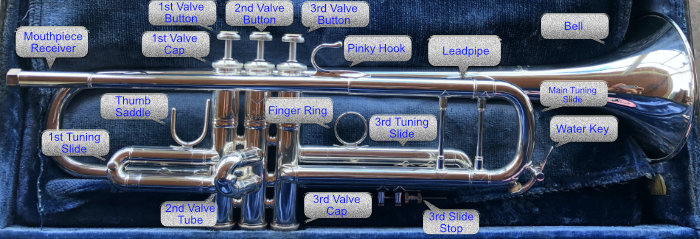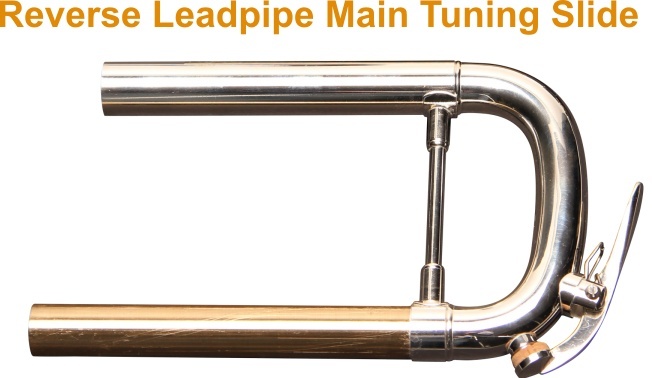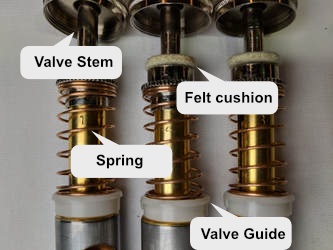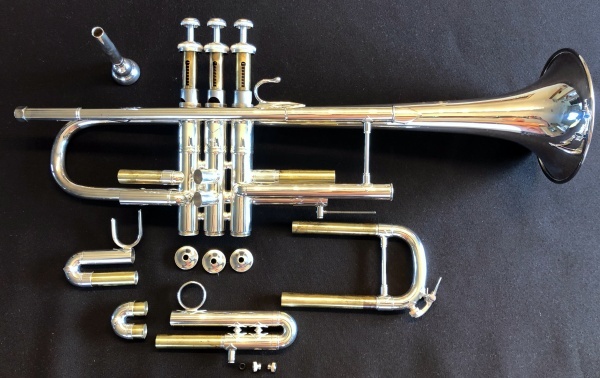What the heck is a “Water Key”? I’m pretty sure that’s not plain water that’s coming out. “Spit Valve” makes more sense, but it’s not a valve. What gives? What are all these parts and why are they important to the sound? Trumpets, Flugelhorns, and Cornets have a surprising number of parts. Would you like to know all their names to amaze your friends and bore your not-so-friends? Here is the anatomy of a trumpet for your dissection fun.

Vincent Bach Stradivarius Trumpet Model 180 with a #37 bell.
Table of Contents
Trumpet Bell
The bell of your horn is the big thing that amplifies the sound you make by buzzing into your mouthpiece. It gives character to your sound by the taper of the flare (how quickly it opens up) and how it vibrates. For example, Vincent Bach Stradivarius trumpets can have different bells denoted by a number. The #37 bell is the most common (like the model 190-37 which is the 50th Anniversary Bach Stradivarius trumpet with a #37 bell) . It’s made from one-piece of hand hammered, yellow brass. The hand hammering or annealing (hardening) is done by artisans so the bell is stiff enough to withstand handling and vibrate evenly. It has a seam that is welded and aligned along the braces that connect it to the rest of the trumpet. This allows the rest of the bell to vibrate more freely and uniformly. It has one of the most recognizable, rich sounds. Bach Stradivarius trumpet models also come with the #43 bell (like the model 180 43 which is the Bach Stradivarius trumpet with a #43 bell) The #43 bell has a slower taper which gives a bit brighter timbre and a bit greater projection. bell is offered in yellow brass (70% brass, 30% zinc) and also gold brass. The gold brass has more brass (85%) and less zinc (15%). The softer brass gives a slightly warmer timbre.
Trumpet Lead Pipe
The lead pipe (or more commonly leadpipe) his another part of your horn that greatly affects the sound. These tonal qualities are sent through the rest of the horn and amplified by the bell. The first thing is the taper of the leadpipe. The taper, or how quickly it goes from small to large from the mouthpiece receiver to the main tuning slide impacts both the resistance you’ll feel and the sound. For example, a faster tapering leadpipe (opens quicker) will let you blow freer. Couple that with a slower opening bell (like the #43 on the Bach Stradivarius) and you have a more brilliant, projecting sound. A darker sound combination would be to have a slower tapering leadpipe (which will give a bit more resistance for a more stable airstream) with a faster taper bell. Many leadpipes are made of gold brass which offers a bit more corrosion resistance.
Reverse Leadpipe
There is also something called a reverse leadpipe. The Bach Stradivarius Model 180 with a #37 pictured above has the most common main tuning slide. When removed, you’ll see that the two tubes slide into the leadpipe and the tubing going into the valve cluster. The reverse leadpipe design (below as an example) has the leadpipe sliding into the tuning slide and the bottom part sliding into the tubing that goes into the valve cluster. In general, it makes for a longer main tuning slide which moves the gaps (when the slide is opened for tuning) further away from the mouthpiece. The idea is that it will help open up the blowing of the trumpet and offer a bit brighter sound. Since a trumpets timbre is affected by the vibrations allowed (or not), the bracing of the tuning slide and placement of braces on the bell will also affect the color of the sound.

Trumpet Tuning Slide or How To Tune A Trumpet
The main tuning slide is how you tune your trumpet or cornet. Both horns are in the key of B-flat so you tune it by playing a “C” in the middle of the staff, then play a B-flat on a piano (or other instrument that is in the key of “C”). Start with the trumpet tuning slide all the way in and extend it to flatten or lower the pitch of your note to match your reference (e.g. the piano playing a B-flat). Most flugelhorns have a mouthpiece receiver that also slides in and out to allow you to tune it.
Trumpet tuning slides also come in different shapes. The one above is the most common “D” shape. There are also ones that come in a “C” shape where there aren’t two sharp bends in it, only a smooth round curve. The idea is that it provides slightly less resistance. The “D” shape has been around for much longer and is designed with the rest of the trumpet components to work best together. A few trumpets come with both and it gives you the opportunity to try different combinations of mouthpieces with them to best match your playing style and music selection.
Mouthpiece Receiver
The “Receiver” is where you install your mouthpiece. It’s job is to accept the mouthpiece shank and minimize any disruption of your airflow into the “Leadpipe”. It’s one of the parts that takes the most abuse on your horn. If you’ve ever had your mouthpiece get stuck, the receiver is often damaged when a mouthpiece remover tool is used. Be gentle when inserting your mouthpiece and when removing it. The reason is that the “Receiver” is soldered to the “Leadpipe” and if damaged, means a trip to a qualified instrument specialist to be repaired.
Trumpet Valve
The valves are numbered from 1 to 3 with the first valve being closest to you and your mouthpiece. The part that you place your fingers on are called “Buttons”. They are usually screwed into a valve stem which goes through the hole in the top “Valve Cap”. Below the “Valve Cap”, there is a “Cushion”, usually made of felt. It’s job is to cushion the valve when you release it and the “Spring” pushes it back to the up position. They don’t do well when wet so when you are cleaning your horn, keep them dry. This is also the reason that putting valve oil on the valve stem with the top valve cap screwed down, doesn’t oil the valves. The “Cushion” just soaks up the valve oil.
There are different types of “Valve Guide” parts used by different makers of trumpets, flugelhorns, and cornets. Most “Valve Guides” are made of nylon where older ones were made of brass. A “Valve Guide” will usually have a slot or a tab which fits into a slot or tab in the valve cluster. It’s supposed to makes the valve go in the right way. Usually, there is only one way a valve can go in but on some horns, the “Valve Guide” can let the valve go in 180 degrees off. You’ll know right away as you can’t blow through the horn. When this happens, unscrew the valve cap, rotate the valve 180 degrees and try again.

Inside each valve cluster tube, the valve has holes which directs the air straight through the horn or when depressed, through the additional tubing. This additional tubing lowers the sound by steps.
- No valves depressed: Reference Note (e.g. G and C)
- 2nd valve depressed: Note is a 1/2 step lower
- 1st valve depressed: Note is 1 step lower
- 3rd valve depressed: Note is 1 and 1/2 steps lower
- 1st and 2nd valves depressed: Note is 1 and 1/2 steps lower
- 2nd and 3rd valves depressed: Note is 2 steps lower
- 1st and 3rd valves depressed: Note is 2 and 1/2 steps lower
Valve Slides
The most common “Valve Slide” is on the third valve tubing. It usually has a “Finger Ring” where a finger of your left hand goes in. The purpose is that when you depress the third valve, you extend the third slide to lower the note slightly to stay in tune. Many horns also have first valve slides with a “Thumb Saddle”. This is where the thumb from your left hand goes.
Water Key or Spit Valve
The “Spit Valve” or more nicely named, “Water Key” is where you get rid of all the moisture that builds up in your horn. “Moisture” meaning your spit. Every trumpet, cornet, and flugelhorn has a “Spit Valve” on the “Main Tuning Slide” because it’s closest to your mouthpiece and well, where the spit comes from. A nice feature is to have one on the “Third Valve Slide”. This is because the “Bell” is most often lower than the “Mouthpiece” when played so your spit tends to gather in the those places. The most common type are just levers with a cork or rubber stopper. Getzen is most famous for using “Amado” “Water Keys” which are round and have a pushbutton. The idea is that they disrupt the airflow less. Make sure to empty these often when playing and before putting your horn away after playing.
Bach Trumpet Parts
The Bach Stradivarius Trumpet is arguably the most popular trumpet out there. It’s been around forever and pretty much everyone knows them almost by sight. The good news about that is spare parts are readily available. Here’s a list of the common parts DIY instrument repair that you can replace on your own. Save yourself a trip to a musical repair shop and some cash.
Affiliate disclosure: As an Amazon Associate we earn qualifying purchases. This is to help support this site. This means if you click on links on reviewed products, we may earn a small commission on your purchase from Amazon. Please note that your price does not increase because of this. Thank you in advance for supporting the band.
Bach Stradivarius Trumpet Parts
- Trumpet Repair Kit
- Trumpet Valve Parts
- Springs
- Guides
- Washers
- Buttons
- Gold Trim Kit
- Third Valve Tuning Slide Parts
- Nuts
- Stop Rod and Nuts
- O Rings
- Main Tuning Slide Water Key Parts
- Water Key Spring
- Water Key Screw
- Water Key Lever
- Main Tuning Slide
Bach Stradivarius Valve Parts





Bach Gold Plated Trim Kit
To take your Bach Stradivarius up several notches. 24kt gold plated, Genuine Bach Stradivarius top caps, bottom caps, valve stems, spit valve, and pearl buttons.

Third Valve Tuning Slide Parts
The most common part that gets lost on a Bach trumpet is those lock nuts for the third valve slide. For some reason, mine kept growing feet and walking away.

Main Tuning Slide Water Key Parts





